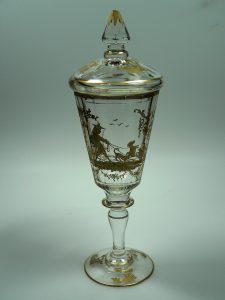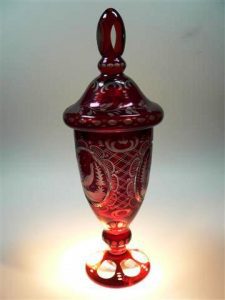Bohemian glass: Lidded goblets - German/German

Gold ruby glasses went out of fashion as luxury items at the end of the 18th century. They were replaced by crystal glasses with gold decoration - like the Bohemian lidded goblet before you. Around 1840, Friedrich Egermann from Bohemia developed a ruby-red glass dye that could no longer be applied as an overlay but by painting onto the colourless glass. The glass was stained red or rubied. This possibility of colouring any glass red led to the mass production of ruby-red glass. Goblets were particularly popular - with or without lids.
Lidded goblets were first and foremost drinking vessels and the lid had a thoroughly practical use! Pollution, quick cooling or warming of the drinks was one reason. The other was the panic fear of poisoned drinks, which were used to get rid of unpleasant rulers. Until the 18th century, a cupbearer served the drinks. He made sure that the wine was poured from the barrels into covered jugs or goblets. These were then displayed in the hall on a sideboard, the so-called credenza. The name Kredenz, from the Italian "credenza", means trust. If the drink foamed during the tasting or the cupbearer sweated when he came close to it, poison was indicated. Only when all the tests had been passed was the drink allowed to be served to the guest.
Bohemian Glass: Goblet with Lid - English

Cranberry, or Gold Ruby glass was a luxury article that fell out of fashion at the end of the 18th century. It was replaced by crystal glasses with gold decor, like the Bohemian goblet with lid before you. In around 1840, Friedrich Egermann from Bohemia developed a ruby-red glass colour that not only overlaid the glass, but could also be painted onto colourless glass. The glass was eiter stained or "ruby-ized," this of course led to the mass production of ruby-red glass and these goblets, with or without lids, were an especially popular model.
Goblets with lids were used first and foremost for drinking out of and the lid had a practical use: to prevent the contamination, or fast cooling or warming of drinks for one and two, there was also a panic-stricken fear of poisoned drinks at the time, which were used to clear disagreeable rulers out of the way! This is why a cupbearer served the drinks into the 18th century. This person made sure that wine from the barrels was poured into jugs or goblets with lids. These were then put on show in the banqueting hall on a type of sideboard known as a credenza. The name of this piece of furniture is Italian and means trust. If the drink frothed during the cupbearer's initial tasting, or he began to sweat as he put the goblet to his lips, poison was afoot! So, only when all initial tastings were complete, would the drink be given to a guest.